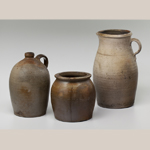Research Note: Nineteenth-Century Stoneware Makers of Madison County, Kentucky
Bob Noe

Kentucky’s Madison County was a vibrant center for salt-glazed stoneware production for fifty years driven by the work of more than a dozen identified potters. From the 1840s through the close of the century—before the rise in popularity of the region’s Bybee/Waco art pottery—Madison County’s multi-generational potteries, numerous partnerships, and sporadic liquidations and acquisitions created a dynamic but relatively untold chapter in Kentucky’s ceramics history. Stories abound about the roots of Madison County’s pottery tradition, but documentation supporting them has been scarce.[1] Regardless, the county’s white and gray clay deposits were a significant natural resource that provided an ample livelihood for stoneware potters. Today, the salt-glazed stoneware made in Madison County is well regarded and highly sought after by collectors and museums. The pottery is distinctive in that it is notably plain in decoration when compared to other Kentucky stoneware made in the first half of the nineteenth century. Potters … Continued

